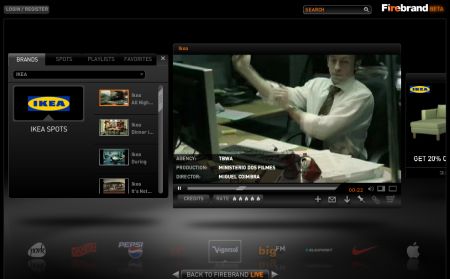von Roland Hachmann | Nov. 30, 2007 | Ad News, Blog, Digital Marketing, Marketing, Social Media Marketing
There is an interesting short post at one of the NY Times blogs about the evolution of beacon, Facebooks new project to include behaviour on third party sites within the news feed and profile. They show different types of popups of how Facebook alerted their users in a more or less obvious fashion about including third party information on their feed.
It started with a popup merely stating the fact, that the information will be passed on. Not reacting to it was assumed as approval. It disappeared after a short while and if you missed it, you „approved“ of the information transfer. Later versions included opt-outs, opt-ins, etc.
Facebook executives tell reporters that users who ignore the alert boxes will no longer be considered to have said “yes,†even after two days. If users ignore the alert box, Facebook says it will not post the news of their purchases to their friends. This is a big change, if implemented correctly. Users will still be hassled by the alert boxes from Facebook on its partner sites, but ideally they can ignore them now and not worry about their purchases being shared.
Facebook executives say they do not want to add a universal opt-out button because then users would not be able to try out Beacon on different sites to see what it can offer. One Facebook executive predicts that consumers may “fall in love†with Beacon once they understand it. Only time will tell.
A very broad prediction, which I don’t believe. But we’ll see.
It’s amazing that facebook started with such an opt-out clause – including the fact that you only had a few seconds to opt-out until the popup would disappear. Now I know that in the US, opt-out is legally viable, which it isn’t in Germany. Here in Germany, nobody would have even considered opt-out in the first place.
But that doesn’t make it an „American approach“ per se. I think, it rather looks like an amateurish approach to treat users in that way and I am not surprised that they changed it to the later versions. I would have assumed that they start with the opt-in approach right away, thinking user-centric instead of brand-centric. But hey.
von Roland Hachmann | Nov. 29, 2007 | Ad News, Blog, Digital Marketing, Marketing, Online Advertising
Firebrand now launched, and it has a wide selection of TV commercials online to watch. You can filter them by brand, animation, celebrity, etc. I particularly like the filter-selection „banned“, which could be quite promising in the future.
What I miss: you can’t comment on the ads. You can rate them, but not comment on them. Might be due to lack of editorial staff, and I hope that is the only reason. Because some say, it might be, because advertisers have expressed concerns about people commenting on ads.

One intelligent feature: as you can see on the screenshot above: offers of the advertisers can be integrated as clickable banners. Not sure if that always corresponds to what has been shown in the ad, but it would make sense.
So who will actually use this? Some people who seek entertainment? They would go to YouTube, wouldn’t they? And the ad folks? Only if this becomes more complete than other ad databases (including YouTube).
And what about including good print advertising?
von Roland Hachmann | Nov. 20, 2007 | Ad News, Blog, Digital Marketing, Marketing, Marketing Trends, Online Advertising, Social Media Marketing
Sofar, advertising on joost has only been in the form of short ads at the beginning or end of clips. Sort of like the traditional ad model.
Now we have the first attempt at actually providing added value through a marketing tactic. In this case, a widet:
On Thursday, Joost announced that Coca-Cola’s European division has created the first „commercial widget“ for the software. Called „Coke Bubbles,“ the downloadable advertising widget lets you choose a clip on Joost and then send it to fellow Joost users, appended with a note in the form of a „bubble.“
You can download it at „Coke Bubbles„. While I am unsure about whether this is a really clever idea, I do support the fact that Coke does not just run ads in the clips, but does try to provide added value. It’s a first step in the right direction.
A lot of marketing efforts will have to provide a clear added value in the future. Either through real product information at the points where consumers are seeking information. Or, alternatively, if consumers are not seeking product information, brands can help to provide plattforms, contents or tools for entertainment or networking – two of the other main things people seek out in digital media these days.
von Roland Hachmann | Nov. 16, 2007 | Blog, Digital Culture, Digital Marketing, Marketing, Marketing Trends, Online Advertising, Social Media Marketing
(Only two Links today:)
von Roland Hachmann | Nov. 12, 2007 | Ad News, Blog, Digital Culture, Digital Marketing, Marketing Trends, Social Media Marketing
Interesting. There is a post at the „social media today“ blog that states that conversational marketing will outpace traditional marketing by the year 2012. The main obstacles at the moment seem to be:
“Manpower restraints†– 51.1%
“Fear of loss of control†– 46.9%
“Inadequate metrics†– 45.4%
“Culture of their organizations†– 43.5%
“Difficulty with internal sell-through†– 35.8%
The second point should be easier to manage, once the first point has been solved. But that needs success on point 5, which depends on point 3, because point 4 necessitates success on point 3. Confusing? Yes. But doable. And very necessary.


 Wo ich sonst so bin...
Wo ich sonst so bin...